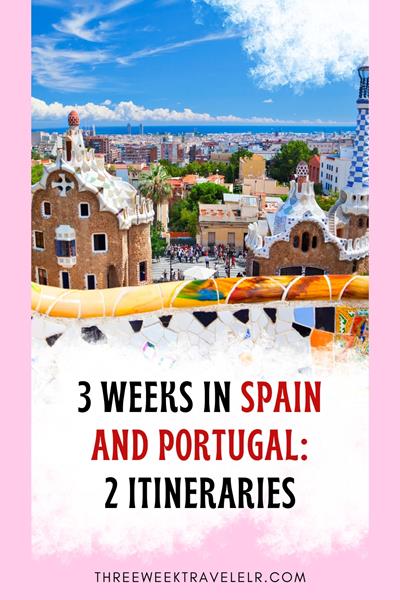Spain and Portugal are two countries that many people assume to be similar. While it’s true in some parts, there are huge differences between these two places, whether it’s culture, history, food, and of course, language.
Spain and Portugal are located in Southwest Europe, near France and Italy. Both countries have coastlines on the North Atlantic and territories in Northwest Africa.
When I considered visiting Portugal and started planning, it made me realise how close Spain and Portugal are to one another and how easy it is to travel between them. Since I’ve never been to Spain, including it on my Europe trip sounds exciting.
I spent 3 weeks in Spain and Portugal. Since I’ve been to Portugal before, I decided to spend 9 days there and 11 days in Spain. Below, I’ll show you how I planned my trip to give you some ideas and tips on curating a suitable itinerary.
You can also make the most out of your time in Europe by spending 3 weeks in Spain, France, and Italy.
THINGS TO KNOW BEFORE GOING TO SPAIN AND PORTUGAL
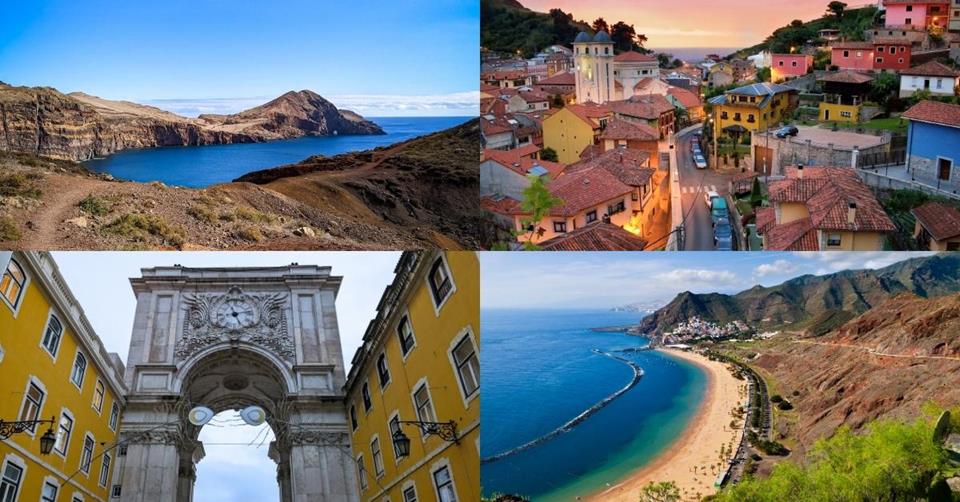
Before booking your flights, knowing these basic but important things about visiting Spain and Portugal is important. This information will help you decide when to go, get an idea of how to get around, what mode of payment is acceptable, the cost of the trip, and more.
When is the best time to go
There’s no one answer to this question because the best time to travel to Spain and Portugal depends on what you plan to do and your budget. For example, if you’re on a budget, you want to avoid the high season from May to August or Christmas.
If you want to avoid the busy season and the rainy months, the best time to go to Spain and Portugal for a 3-week trip is from January to April or September to October. The water will be a bit cold, but the southern you go, the better if you want to do water activities.
Here is more information about the seasons in Portugal and Spain:
- Summer Season: June to August. Warm temperatures, particularly in inland areas.
- Peak Season: July and August. Tourists flock to beaches, cities, and cultural sites. Accommodations and attractions are the busiest, and prices can be higher.
- Low Season: November to February. Fewer tourists, cooler temperatures, especially in northern areas. Accommodations are generally cheaper and attractions less crowded.
- Winter: December to February. Mild on the coast, colder inland, and snow in mountainous regions like the Pyrenees in Spain.
- Rainy Season: Primarily in northern Spain and Portugal (Galicia, Asturias). The heaviest rainfall is from October to December but varies by region.
Are 3 weeks enough for Portugal and Spain
Yes, although you can’t visit all fantastic areas, you can still explore 5-6 cities, especially if you don’t plan to go to the Canary Islands since that trip alone will take out a full travel day.
The flight is not long, but considering the time you have to arrive at the airport, it’s hard to plan an activity during the day you are flying.
Arranging good and reliable transportation is the key to making sure you make the most of your trip here. We’ll discuss more about transportation in a little bit.
What to pack
Pack what you normally bring for a 3-week trip, but make changes depending on the season. A few things that you must really have are clothing for sacred places. You have to dress modestly for churches.
That includes covering your shoulders, down to your knees, and even your head for women. Make sure you bring a lightweight scarf that can be used as a beach towel and head coverage or an impromptu skirt.
And the fact that this is Europe, you definitely want to bring comfortable walking shoes .
We have lots of packing lists for a 20-day trip, such as a spring packing list, a winter packing list, an autumn packing list, and of course, a summer packing list.
How to get around
The main modes of transportation both in Spain and Portugal are buses, trains, planes, and cars. To get around the cities, you can use ride-hailing apps such as Uber, Bolt, Moovit, and Cabify. Make sure these apps are downloaded on your phone, and the payment is set before you arrive here.
Here are some more tips about transportation in Portugal and Spain:
- Fastest Way: Both countries have well-connected domestic flight networks. The common airlines are TAP Portugal, Iberia Airlines, Air Europa, and Ryanair. High-speed trains, like Spain’s AVE, also link major cities swiftly.
- Cheapest Way: Buses are generally the most economical mode for long distances. Both countries have extensive bus networks with companies like ALSA (Spain) and Rede Expressos (Portugal). Trains, especially regional ones, can be affordable when booked in advance.
- Renting a Car: Recommended if you plan to explore rural areas or smaller towns off the main transit routes. Both Spain and Portugal have well-maintained roads and highways. However, consider the following:
- In cities, parking can be a challenge and expensive.
- Both countries use toll roads, which can add to travel costs.
- Familiarize yourself with local driving customs and regulations.
- Most rental vehicles both in Spain and Portugal have manual transmissions. You can find automatic for a higher price.
- Local Transportation: Major cities in both countries have efficient metro, bus, and tram systems. Madrid and Barcelona in Spain and Lisbon and Porto in Portugal have particularly extensive metro networks.
Recommendation: If your itinerary covers major cities, rely on trains and local transportation. Rent a car for specific legs of your journey where public transport might not be convenient or for exploring countryside areas.
I mostly travelled by plane and bus. However, for intercities, I walked a lot and used apps if the walk was longer than an hour, it was raining, or I was running late. We were two people travelling together, so using the ride-hailing app was more convenient than the local bus.
Language and currency
In Spain, the main language is Spanish (Castilian Spanish), while in Portugal it’s Portuguese. Tourists will find that in major cities and popular tourist destinations, many locals speak English, especially the younger generation.
Most attractions, hotels, and restaurants in these areas often have English-speaking staff. Although navigating both countries using English is typically straightforward, it’s always appreciated when visitors make an effort to use basic local phrases. However, in rural regions, English proficiency might be more limited.
The primary currency in both Spain and Portugal is the Euro (€). USD is not commonly accepted, and tourists are generally expected to pay in Euros. While many establishments in cities and tourist hubs accept credit and debit cards, cash is preferred, especially in smaller towns and for smaller transactions.
It’s advisable for foreign visitors to carry a mix of both cards and cash. ATMs are widely available, and for the best exchange rates, it’s recommended to withdraw or exchange money at local banks.
Average travel cost for Spain and Portugal for 3 weeks
Travel cost in Spain and Portugal for 3 weeks varies a lot. It’s advisable to set a budget and then have emergency money for 5 days’ worth of expenses.
I personally budgeted for €80 per day, but actually ended up spending around €1,200, minus the flights and travel insurance. I stayed in a mixture of hostels and budget/mid-range hotels.
These numbers exclude international flights and travel insurance, but it’s advisable to book these in advance to avoid expenses at the end of your trip:
- Affordable/Backpacker: €750-€1,200
- Stay: Hostels, budget guesthouses.
- Food: Street food, local markets, self-catering.
- Transport: Public buses, walking, and occasional regional trains.
- Activities: Free attractions, self-guided tours.
- Mid-range: €1,200-€2,500
- Stay: 3-star hotels, boutique guesthouses.
- Food: Mid-range restaurants, some fine dining.
- Transport: Intercity trains, domestic flights, local public transit.
- Activities: Guided tours, and entrance fees to attractions.
- Luxury: €2,500-€6,000+
- Stay: 4-5 star hotels, luxury resorts.
- Food: Fine dining, gourmet experiences.
- Transport: Private transfers, first-class trains/flights.
- Activities: Private guided tours, exclusive experiences.
If you plan to travel with your children, you have to factor in that they need their own tickets for flights, but for hotels, if they’re under 18 years old, they can share a room with you.
Visa
Spain and Portugal are part of the EU and implement the visa policy of the Schengen States. This means that visitors with passports from the EU are free to enter and travel around these two countries for a longer time.
Foreign travellers with a passport from the US, Canada, the UK, Australia, New Zealand, Japan, South Korea, Malaysia, Singapore, and most places in Latin America can enter and travel in Spain and Portugal for 90 days in a 180-day calendar period.
The rest of the world must apply for a visa in advance (it can be done as early as 6 months prior to your trip). The visa will be valid for both countries for the number of days you have been granted.
Other travel tips
PINNED MAP OF MUST-SEE PLACES IN SPAIN AND PORTUGAL
Click the enlarge button on the top right corner. Credit: map data: Google
3 WEEKS IN SPAIN AND PORTUGAL ITINERARY
I love many things about these two countries, but I’m eager to find out what makes them different from one another. During my trip, I decided to mix both renting a car and driving by bus, train, and domestic flight.
If you want to go to the Canary Islands (Northwest Africa), you need to take a short flight (around 2-3 hours).
When creating your own itinerary, make sure to check if there are direct bus or train routes between the cities to make it easier to get around. And finally, you don’t have to start and end in the same city since many cities in Spain and Portugal have many international flights.
This itinerary is suitable for people visiting Portugal and Spain for the first time, love to learn about history and culture, do outdoor activities, visit castles, and enjoy mouthwatering local dishes and wines.
ALSO READ: 3 weeks in Southern Europe itinerary
Itinerary #1: First-timer (Madrid, Barcelona, Seville, Malaga, Algarve, Porto, Lisbon)
This itinerary is perfect for first-time visitors to both countries. It highlights the must-see sites and balances historical locations, natural beauty, and cultural experiences. Start in Madrid, Spain and finish the trip in Lisbon, Portugal.
Visit Spain and Portugal to experience its interesting culture, history, and natural beauty. Madrid offers world-class museums and exciting nightlife. Barcelona features Gaudí’s architectural marvels and beachfront vibrancy.
Seville, with its historic Alcazar and passionate flamenco. Malaga, the birthplace of Picasso, combines coastal charm with ancient fortresses. The Algarve’s stunning coastline is highlighted with golden beaches and dramatic cliffs.
Porto is known for its port wine and historical Ribeira District. Lisbon, the sun-kissed capital of Portugal, is surrounded by its hilltop views, tram rides, and trendy neighbourhoods.
If you have 3 weeks in Spain and Portugal, you can’t miss each country’s capital cities. Not only rich in history and a melting pot of culture, using these cities as a travel hub to enter and exit is very convenient.
If you want to rent a car, I only recommend you do this in Portugal. The distances between the cities in Spain are too great. Unless you plan an itinerary and choose cities near one another, driving on your own is a good choice.
Madrid for 3 days
Madrid, Spain’s capital, is a blend of old history and modern energy. It has world-renowned museums like the Prado and Reina Sofia, showcasing impressive art collections. The city’s life is in its grand plazas, notably Puerta del Sol and Plaza Mayor.
With its Royal Palace, verdant Retiro Park, and Gran Vía, Madrid offers a unique mix of cultural experiences, green spaces, and urban dynamism, all complemented by its yummy cuisine.
Use this time to arrange your car rental if that’s your plan and get some local currencies, a local sim card with data, and book transportation between cities or to your next destination.
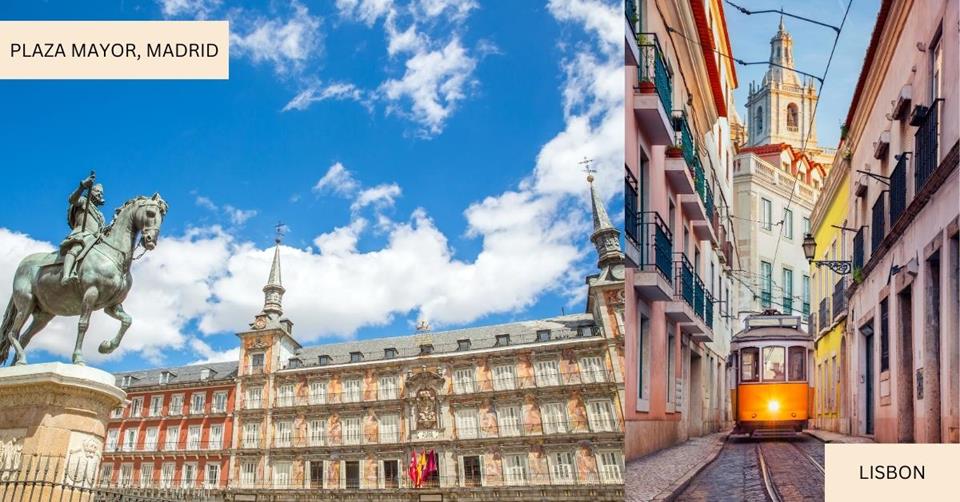
Barcelona for 3 days
Barcelona is located between mountains and the Mediterranean and is a feast for the senses. It is celebrated for Gaudí’s architectural masterpieces like Sagrada Família and Park Güell and offers a unique blend of historic and avant-garde.
Explore the historic Gothic Quarter to the bohemian El Raval. Barcelona’s beachfront boardwalk, traditional markets, and rich Catalonian cuisine makes its a must-visit destination.
If you’re driving, travelling between Madrid and Barcelona takes 6 hours and 30 minutes. For those using the train, it takes less than 3 hours. You can also fly, which is around 1 hr and 20 minutes.
Seville or Malaga for 4 days
I recommend you choose between these two cities; one is on the south coast, and the other is more on a landlocked city. You can’t go wrong. Both these Andalusian cities offer unique history, culture (especially Moorish), and tasty local dishes (hello tapas!).
Malaga, a sunny coastal city, is the gateway to Spain’s Costa del Sol. Beyond its beaches, it’s Picasso’s birthplace, housing a museum showcasing his works. The Alcazaba fortress offers panoramic city views, while the Roman theatre is a reminder of its ancient roots.
Seville, the heart of Andalusia, captivates with its rich Moorish heritage. Here, you can stop by the Alcázar Palace and Giralda Tower. The city also has traditional festivals, like Feria de Abril. Enjoy a leisure walk at the Santa Cruz Quarter and at the Plaza de España if you’re looking for an easy day of exploring.
Both are too far from Barcelona, so booking a flight or train is the best choice. From Barcelona to Seville or Malaga, the train is less than 6 hours; both choices stop in Madrid and might require a change of train. If flying, both destinations are a 1 hr and 40-minute direct flight.
Lisbon for 4 days
It’s time to bid goodbye to Spain and time to explore Portugal. The first destination is Lisbon, the capital city.
If you want to rent a car, this is an excellent mode of transportation for this part of the itinerary. Driving between Lisbon to Porto, to Algarve, and back to Lisbon gives you freedom of your time, and the drive is no more than 3 hours each.
Lisbon, Portugal’s coastal capital offers hilltop vistas and historic tram rides. I don’t think I’ve been to a hillier city (with cobbledstones) in Europe. A city of seven hills, its neighbourhoods, from the bohemian Bairro Alto to the historic Alfama are the places to go where you can enjoy the traditional Fado music.
Don’t miss the beautiful Belém Tower. It was raining when I got there, but still worth the visit. You can also visit Jerónimos Monastery, but on the way to the Belem Tower, I stopped by Padrão dos Descobrimentos.
To reach Lisbon from Malaga or Seville, there’s a direct flight that takes an hour. You can pick up your car rental at Lisbon Airport (Humberto Delgado Airport) and set the drop off here too when you catch your flight home.
Porto for 3 days
Porto is along the Douro River, is a blend of historic charm and modern vibrancy. Come for its port wine, stay for its locals and beautiful sceneries. You can explore wine cellars and sample exquisite varieties. Don’t forget to join a vineyard tour with wine tasting.
The iconic Dom Luís I Bridge offers breathtaking views, while the Ribeira District, with its colourful and narrow streets. Don’t forget the Livraria Lello bookstore, and then head down to Bolhão Market are a great way to finish your day.
Getting to Porto from Lisbon is easy and you have plenty of options. The bus is the cheapest choice which will take 3 hr and 30 minutes. The train travel is the same, but it’s more scenic and comfortable. Driving will be around 3 hours. There’s also a domestic flight for an hour.
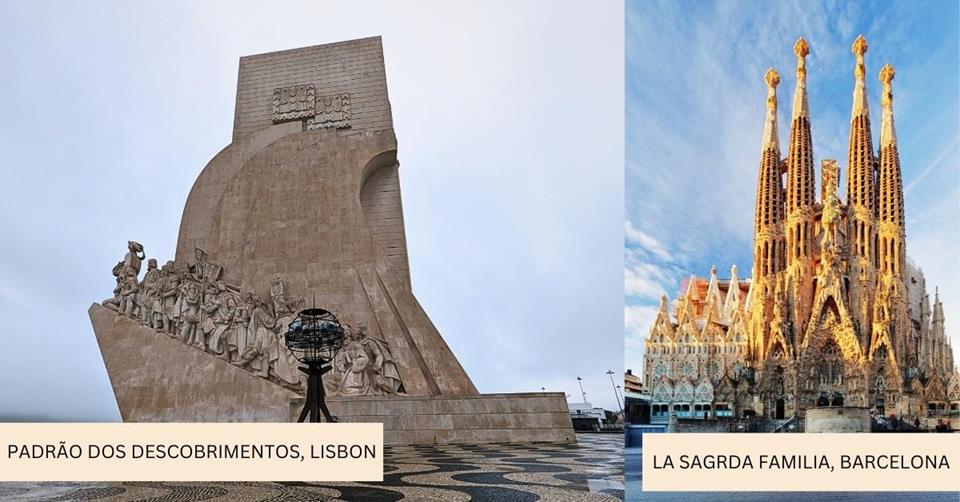
Algarve for 3 days
As the final leg of your trip, it’s the Algarve region. Portugal’s southernmost region is a sun-drenched haven of golden beaches and turquoise waters.
With its stunning and dramatic cliffs, hidden coves, and historic fishing villages, it’s a paradise for sun-seekers and adventurers alike. The region is filled with charming towns like Lagos and Tavira, where you will also find signs of the Moorish history.
The Algarve is the best place to end your trip because you can enjoy the beach and water activities here. You can fly from Porto to Faro airport; it’s a non-stop 1 hr and 10-minute flight. The drive will take 5 hours, the bus is around 7 hours.
When you’re ready to leave, you can take a bus to Lisbon or a direct flight from Algarve. If you rent a car, the drive is 2 hr and 45 minutes.
Itinerary #2: Hiking and Beaches (Barcelona, Valencia, Ibiza, Lisbon, Algarve, Madeira Islands, Tenerife)
There are so many good things Portugal and Spain offer to its foreign visitors. But if you’re after exciting hiking trails and pristine beaches, that’s also possible. I personally love this itinerary because it offers an amazing opportunity.
My own itinerary was a mixture of Itinerary #1 and #2. I visited during the autumn/fall season, so I didn’t get to enjoy the water that much. The water temperature was around 20°C, it was not bad, but I don’t enjoy cold water.
3 weeks in Spain and Portugal, you can’t miss the Canary Islands, which both countries have territories. Namely Madeira Islands, Tenerife, and Gran Canaria. I did a lot of hiking both in the Madeira Islands and Tenerife.
You can definitely do both. Go to 3 cities in Spain and 3 cities in Portugal. If you want to save a bit of money, choose only one between Tenerife, Gran Canaria, and Madeira Islands and swap it with a city on the mainland.
Barcelona for 4 days
Barcelona offers the best of both worlds for nature enthusiasts. It’s right between the Montserrat Mountains and the Mediterranean Sea, and it provides avid hikers with trails leading to panoramic city views, like those from Montjuïc and the Collserola range.
The city’s coastline has lots of beaches such as Barceloneta and Nova Icaria, perfect for sunbathing and water sports. Just a short journey away, the rugged Costa Brava coastline offers secluded coves and scenic coastal hikes.
From Barcelona, the Pyrenees region is only 3 hour’s drive, so that’s another option for hiking. Popilar areas includes Parc Natural del Cadí-Moixeró, Parc Natural de l’Alt Pirineu, and Aigüestortes i Estany de Sant Maurici National Park.
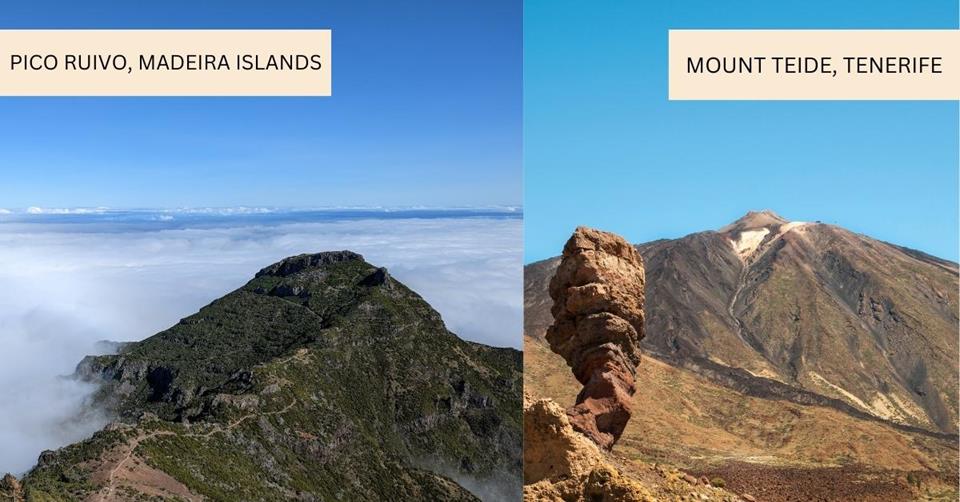
Valencia or Ibiza for 3 days
You should choose between these two locations because going to both will cost you time. Go to Valencia if you want to stay on the mainland and have the option to do day trips around the city. You should also skip Ibiza if you don’t want to take the ferry.
Valencia, on Spain’s eastern coast, is a haven for those drawn to nature and the sea. Its pristine urban beaches, like Malvarrosa and Patacona, are amazing places for relaxation and water activities. The nearby Albufera Natural Park has some exciting and easier hiking trails, plus birdwatching opportunities.
For the avid hiker, the mountainous regions around Valencia, such as the Sierra Calderona, present challenging trails with breathtaking views.
For those looking for a classic party island, Ibiza is the place for you. Ibiza, a jewel of the Balearic Islands, has very clear waters and stunning beaches. From the serene coves of Cala d’Hort and Cala Salada to the lively beach clubs of Playa d’en Bossa, Ibiza caters to both tranquil sun-seekers and lively beach parties.
The island’s pristine sandy stretches and rocky coastlines are perfect for sunbathing, snorkelling, or watching the iconic Ibiza sunset. Its coastal beauty truly epitomizes Mediterranean allure.
The fastest way to get to Valencia from Barcelona is the train, around a 3-4 hour’ ride. The drive is around 4 hours. There’s a flight, but requires a connection to Palma or Madrid.
Barcelona to Ibiza by plane is a non-stop 1-hour trip only. I don’t recommend getting to Valencia, then from there taking a ferry. This will take too long and most likely won’t be cheaper than flying.
If you’re opting for Ibiza, you should check this guide next:
Ibiza guide: Where to stay in Ibiza for solo travellersTenerife or Gran Canaria for 4 days
The first thing you should know is that Tenerife has 2 airports, one in the north and the other in the south. So, book your flight depending on where you plan to stay. Gran Canaria only has one airport.
Choose between these two places in the Canary Islands. You can’t go wrong as both are charming, but when it comes to hiking, Tenerife has marked trails, perfect if you’ve never been here before.
Tenerife, the largest of the Canary Islands has a variety of landscapes. There are golden sand beaches, like Playa de Las Teresitas and Playa Jardín. On the other hand, for hiking enthusiasts, the UNESCO-listed Teide National Park offers trails across volcanic terrains at Mount Teide, Spain’s highest peak.
From the lunar landscapes of Llano de Ucanca to the Anaga Mountains, Tenerife combines beachfront leisure with thrilling trekking adventures.
On the other hand, Gran Canaria is a gem in the Canary Islands. It offers a range of nature’s wonders. Its coastline has varied beaches from the Playa del Inglés to Güigüí, which is accessible only by foot or boat.
Inland, the island’s rugged landscapes with trails leading to Tamadaba Natural Park and the ravines of Barranco de Guayadeque.
From Valencia or Ibiza, you can get to Tenerife by catching a flight. There’s a connection in Madrid. Choose and book a flight wisely so you don’t spend more than 5 hours travelling between the two places. From Ibiza or Valencia to Gran Canaria, the flight connects either in Madrid or Barcelona.
Madeira Islands for 4 days
You’re now heading to Portugal’s territory. Madeira Islands is easily one of my favourite hiking regions in Europe (well, Northwest Africa) when it comes to unique ecosystems
I hiked 3 trails and experienced 3 different environments; desert, semi-tropical, and mountain. The beaches here are not as stunning as Tenerife or Gran Canaria, but the lava pools are super cool.
Madeira Islands is a Portuguese archipelago, located in West Africa along the Canary Islands. Its beaches, like Praia Formosa, offer volcanic black sands and serene ocean views. There are also natural lava pools to spend some time in the water.
The island’s “levadas” (irrigation channels) provide unique hiking paths, where you can trek through landscapes, waterfalls, and cloud-kissed peaks. From the coastal charms of Porto Santo to the mountainous terrains of Pico Ruivo, Madeira offers a combo of beach relaxation and hiking escapades.
From Gran Canaria or Tenerife to Madeira Islands, there’s a flight that connects to Madrid. It’s not a cheap flight, so make sure not to book last minute.
Lisbon for 2 days
You can choose between Lisbon and Algarve as your next destination. There’s a direct flight to Lisbon from Madeira Island. If you go to Algarve, you need to connect in Lisbon. These two locations offer different experiences.
But then, the travel between Lisbon and Algarve can be done by bus, driving, or plane. You decide if you want to end your trip in a city or near beautiful beaches.
When it comes to beaches and hiking, Lisbon doesn’t have much to offer, but its historical city is definitely worth a visit. Lisbon, Portugal’s coastal capital, is more than just a busy city. Beach enthusiasts can visit the nearby Cascais and Estoril, while Costa da Caparica offers surf-friendly waves.
For hikers, the Sintra-Cascais Natural Park presents trails through forests, leading to panoramic viewpoints and Moorish Castles.
Algarve for 3 days
Finally, the Algarve. It’s a region in Portugal, not a city. The main airport here is located in Faro District and the most popular place to stay is around Lagos.
The Algarve, Portugal’s sunlit southern coast is honestly an exciting way to wrap up your 3 weeks in Spain and Portugal trip if you enjoy the beach and water activities. Two of its top destinations are Praia da Marinha and Benagil Cave.
The bus drive between Algarve and Lisbon is only 3 hours, the bus is 4 hours and the flight is 50 minutes. I personally like to end my trip in a relaxing place such as Algarve, where I can spend hours on the beach or going for a spa.
MUST-TRY SPANISH AND PORTUGUESE DISHES AND DRINKS
Eating and drinking are two things you can’t skip when visiting and spending 3 weeks in Spain and Portugal. Here’s a list of the top dishes from countries.
I love bacalhau and pasteis de nata from Portugal. While paella and churros are my favourites from Spain – yep, I’m very cliche! Make sure to try at least 4-5 dishes, desserts, and drinks and see which ones you like the most:
Spain:
- Paella – A rich rice dish often featuring saffron, vegetables, and a variety of proteins such as chicken, rabbit, or seafood.
- Tapas – Small appetizers ranging from albondigas (meatballs) to patatas bravas (spicy potatoes).
- Gazpacho – A cold tomato-based soup made with fresh vegetables, perfect for hot days.
- Tortilla Española – A thick Spanish omelette with potatoes and onions.
- Fabada Asturiana – A hearty bean stew with sausages and bacon, typical from Asturias.
- Pisto – Spanish ratatouille made with tomatoes, peppers, zucchini, onions, and eggplant.
- Churros con Chocolate – Fried dough pastries served with a thick chocolate dip.
- Tarta de Santiago – An almond cake from Galicia, often topped with powdered sugar and the cross of Saint James.
- Crema Catalana – Catalonia’s version of crème brûlée, a creamy dessert with a caramelized sugar top.
- Sangria – A fruity wine-based drink mixed with various fruits, sugar, and sometimes brandy.
- Horchata – A sweet and creamy drink made from tiger nuts, typical from Valencia.

Portugal:
- Bacalhau à Brás – Shredded cod mixed with finely chopped straw fries and bound together with scrambled eggs.
- Caldo Verde – A green soup made with thinly sliced collard greens, potatoes, and chorizo.
- Frango Piri-Piri – Spicy grilled chicken seasoned with piri-piri chili.
- Arroz de Marisco – Seafood rice loaded with a mix of fresh seafood.
- Cozido à Portuguesa – A hearty stew made with various meats, sausages, and vegetables.
- Açorda – A traditional bread soup made with garlic, coriander, olive oil, and sometimes seafood.
- Pastéis de Nata – Creamy custard tarts with a crispy, flaky pastry and a sprinkle of cinnamon and powdered sugar.
- Bolo de Bolacha – A rich biscuit cake made with layers of Maria cookies soaked in coffee and interspersed with creamy butter filling.
- Arroz Doce – Portuguese rice pudding, often decorated with cinnamon patterns.
- Vinho Verde – A young, slightly effervescent green wine unique to Portugal.
- Ginjinha – A cherry liqueur, often enjoyed as a digestive in Lisbon and Óbidos.
THINGS TO DO PER CITY
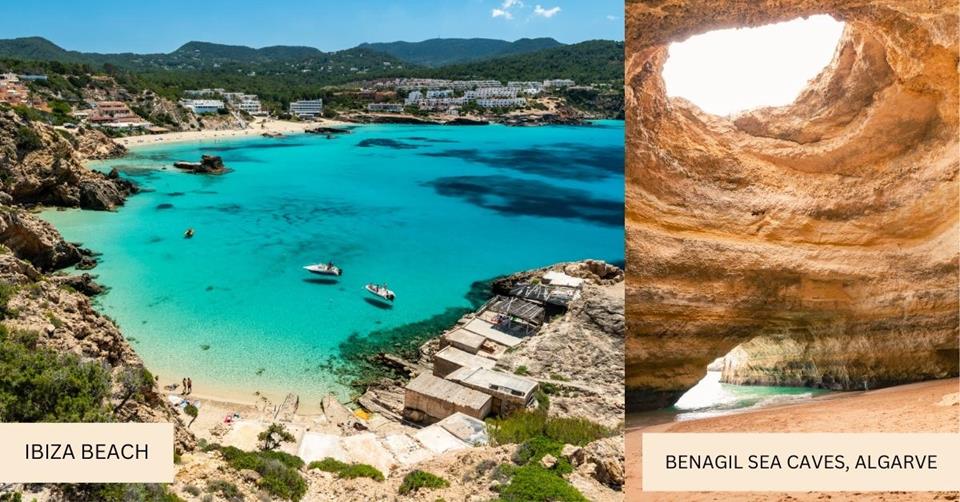
Now that you have some ideas on where to go, how many days to spend in each city, and even a list of food to try, it’s time to show you a list of must-do and must-see activities in each country. I also included a list of recommended tours to book to make your trip more convenient:
Madrid
- Royal Palace – get your fast-access ticket
- Plaza Mayor
- Museo Nacional del Prado – purchase your ticket in advance
- Parque Natural de Peñalara and Sierra de Guadarrama National Park
- Visit Real Madrid’s Stadium (Santiago Bernabéu Stadium) – join a Bernabeu Stadium tour
- Buen Retiro Park and the Crystal Palace
- Puerta del Sol
- Fuente de Cibeles and Gran Via
- Temple of Debod
- Basilica de San Francisco el Grande
- Enjoy wine and tapas tasting – join a group tour
- Puerta de Alcala
- Watch a flamenco show with dinner
- National Museum of Romanticism
- Day trip to Avila and Segovia and visit historical sites or go to Toledo with a local guide
Barcelona
- Mount Tibidabo
- Barceloneta Beach
- Basilica de la Sagrada Familia – skip the online and explore with an audio guide or combine with Parc Guell
- Casa Mila
- Barcelona Aquarium – suitable for young children, buy your ticket in advance
- Palau de la Musica Catalana
- Park Güell- get your ticket in advance, there’s a limit per day ticket sold for Parc Guell
- Casa Batllo
- Enjoy tapas and wine – book a walking tour
- Bogatell Beach/Playa de Bogatell
- Magic Fountain of Montjuic – ride a round-trip cable car
- Museo Picasso de Barcelona
- Explore Montserrate – join a half-day tour
- Camp Nou
- Trio-day trip and cover Spain, France, and Andorra – check the itinerary
- Walk around Barri Gotic
- Go kayaking and snorkelling in Costa Brava – book an affordable tour
Valencia
- La Lonja de la Seda
- Oceanografic – perfect for young children, get your entrance ticket
- Albufera Natural Park
- La Ciutat de les Artes i les Ciencies de Valencia
- Cuevas de San Jose – sign up for a half-day guide tour
- Mercado Central
- Plaza de la Virgen
- Hike and swim at Montanejos – book a group tour
- Bioparc Valencia
- Torres de Serranos
- Playa del Saler
- Sail on a Catamaran Cruise – check the tour price
- The medieval town of Requena
- Enjoy wine and tapas tasting in an 11th-century historical monument – check this trip
- Join a cooking class
Ibiza
- Join an all-inclusive boat party
- Cala Comte
- Platja de Cala Xarraca – Paul
- Cala Salada
- Platja d’en Bossa
- Cala Benirras
- Cala Bassa – book a 6-hour boat trip around Ibiza
- Cala d’Hort
- Ses Salines
- Hike Camino Al Faro De Moscater
- Faro de Punta Grossa
- Tore de Companitx
- Castell d’Elvissa/Castle of Ibiza
- Book a snorkelling and SUP paddle tour
Malaga
- Enjoy a flamenco show in a cave restaurant – book your table
- Alcazaba de Malaga
- Malaga Old Town/Marbella Urban Wall
- Jardin Botanico-Historico la Concepcion
- Caminito del Rey – book a guided tour to cross the suspension bridge
- Playa de la Malagueta
- Museo Picasso Malaga – get your ticket with an audio guide tour
- Centre Pompidou Malaga
- Do tapas tasting – join a walking tour
- Festival de Malaga
- Day trip to Gibraltar – book a day trip including a St Michael Caves visit
Granada
- Alhambra (G)
- Sacromonte (G)
- Alhambra (G) – check the tour price or do a day trip from Malaga
- Nasrid Palaces (G)
- Salobreña Beach
- Sierra Nevada National Park
- Boat trip to Paseo de Los Delfine – check the price
- Torre Vigía De Cerro Gordo – sign up for a snorkelling and kayak tour
Seville
- Royal Alcazar of Seville
- Catedral de Seville
- Punta Umbria Beach
- Cascadas del Hueznar
- Real Alcazar
- Parque de Maria Luisa and Plaza de Espana
- Barrio de Santa Cruz
- Museo del Baile Flamenco
- Real Maestranza de Caballeria de Sevilla
- Palacio de la Condesa de Lebrija
- Metropol Parasol
- Torro del Oro
Lisbon
- Save money by getting a Lisbon card that allows you to enter top attractions and the public transport system
- Go sightseeing – either on a walking tour or a tuk-tuk tour or an electric bike
- Belem Tower
- Pena Palace – you can do a combo tour that includes Sintra, Cabo da Roca, and Cascais
- Ponte 25 de Abril Bridge
- Sintra – day trip from Lisbon, including Quinta da Regaleria
- Padrão dos Descobrimentos
- Cabo da Roca
- Justa Lift
- Lisbon Cathedral
- Learn about Portuguese cuisine – food and wine tour or half-day food tour or wine-tasting tour
- Miradouro das Portas do Sol
- Day trip to Fatima, Nazare, and Obidos – check the tour price
- Quinta da Regaleira
- Tagus River – go on a Catamaran sunset tour or a cruise on a traditional boat
- Miradouro da Senhora do Monte
- Jardim do Torel
Porto
- Explore Porto – by electric bike or street art tour or tuk-tuk tour or walking tour
- Luís I Bridge
- Duoro Valley – boat tour with wine tasting and lunch or wine tasting, lunch, and optional cruise
- Clerigos Church and Tower
- Livraria Lello
- Vila Nova de Gaia – board a sunset sailboat along Duoro River or 6 Bridges Cruise
- Jardins do Palácio de Cristal
- Day trip to Braga and Guimaraes – check the itinerary and cost
- Porto Cathedral
- Day trip to Aveiro, Paiva Walkways, and Arouca 516 Footbridge – read tour reviews
- Palácio da Bolsa
- Peneda-Gerês National Park – visit waterfalls, lagoons, and old villages
- Casa da Música
- Food tours – 3-hour food and wine tour or 10-dish food tour or pastel de nata cooking class
- Parque Natural do Alvão
- Wine and drinks tours – 7 port wine lodges or pub crawl
- Serra do Pilar
- Go Off-Road Buggy – join an adventure
Algarve
- Punta de la Piedad – boat cruise from Lagos
- The Strip/Rua da Oura
- Benagil Caves – go kayaking or a speedboat or from Vilamoura or from Portimao via a pirate ship
- Praia do Camilo
- Faro District / Ilha do Farol
- Golden Coast – cruise from Lagos
- Praia da Falésia
- Albufeira District – book a beach, bbq, and cruise
- Lagos District
- Ria Formosa – catamaran tour from Faro
- Praia de Dona Ana
- Family Golf Park
- Adventure activities – Off-Road Quad Tour from Albufeira or Jeep Safari
- Parque Natural do Sudoeste Alentejano e Costa Vicentina
- Algar Seco
- Dolphin watching – join a dolphin tour with caves from Albufeira or from Portimao
Madeira Islands
- Old Town Walking Tour
- Explore Madeira Island – join west tour or east tour or a west tour on a jeep or book a 2-day guided tour to save time or get a hop-on, hop-off bus pass
- Hike Punta de Sao Lourencio
- Madeira Botanical Garden
- Ride the Cable Car at Funchal – check the price with Monte Toboggan and the botanical garden tour
- Swim at the Lava Pools / Doca do Cavacas Natural Pools – book a combo tour with Skywalk and Fana
- Hike Pivo Areiero to Pico Ruivo – do a sunrise tour with a transport service or a guided hike with a transport
- Day trip to the Nuns Valley, Monte, and a Sleigh ride – read the tour reviews
- Hike from Baloes (PR11) to Ribeiro Frio (PR10) to Portela or the other way around
- Dolphin and whale-watching – via an eco catamaran
- Porto Moniz – join a 4×4 tour
- Hike PR13 Verada do Fanal
- Go Scuba Diving – check dive price
- Santa Catarina Park
- Join a food and cultural tour
- CR7 Cristiano Ronaldo Museum
- Rancho Cable Car
- Levada Rbacal – tour with 25 fountains
- Nova and Moinho Waterfall
- Adventurous Activities – off-road buggy ride or go canyoning or level 2 canyoning
Tenerife
- Lago Martianez
- Playa de Las Teresitas
- Mount Teide National Park
- Siam Water Park – get your tickets
- Whale and dolphin watching
- Museum of Science and the Cosmos
- Fuerteventura – do a 4×4 tour
- Cueva del Viento
- Masca Village
- Tabaiba Shipwreck/Pecio de Tabaiba
- Bajamar Natural Pools/Piscina Natural de Bajamar Teneriffa
- Sign up for a whale and dolphin watching tour or do a kayak tour while looking for dolphins and turtles
Gran Canaria
- Pico de las Nieves
- Reserva Natural Especial de las dunas de Maspalomas
- Go scuba diving – book a tour
- Playa Puerto Rico
- Drive an ATV – enjoy a tour
- Roque Nublo
- Enjoy a submarine tour – read the reviews
- Palmitos Park
- Sign up for a morning cruise – check the price
ACCOMMODATIONS PER CITY
Finally, you need a place to stay. You must book your accommodations at least 6 months in advance if you’re visiting between May to September or December. The good hotels with reasonable prices get booked up so fast. Here’s a quick list of places to stay in Portugal and Spain:
Madrid
- Affordable: Olblanc Plaza de Espana or Hostal Arrate
- Mid-range: II Castilla Madrid or Hotel Liabeny
- Luxury: Pestana CR7 Gran via Madrid or Palacio de Atocha
Barcelona
- Affordable: Unite Hostel or Factory Hostel
- Mid-range: Sixties Ramblas or Violeta Boutique
- Luxury: Vincci Gala or Ohla Barcelona or ME Barcelona
Valencia
- Affordable: Hostal Antigua Morellana or Colors Rooms
- Mid-range: Ad Hoc Carmen or Venecia Plaza Centro
- Luxury: Vincci Lys or Petit Palace Plaza de la Reina
Ibiza
- Affordable/Mid-range: Hotel Florencio or Lux Isla
- Luxury: Aparthotel Duquesa Playa or THB Los Molinos (adults only)
Malaga
- Affordable: COEO Pod Hostel or Hotel Zeus
- Mid-range: Petit Palace Plaza Malaga or Be Mate Malaga Centro
- Luxury: Soho Boutique Castillo de Santa Catalina or Vincci Seleccion Posada del Patio
Granada
- Affordable: Urban Dream Nevada or Pension Venecia Gomerez
- Mid-range: Nest Flats Granada or Room Mate Leo
- Luxury: Candil Suite Origen or Hospes Palacio de Los Patos or Palacete (adults only)
Seville
You can also check this list of best boutique hotels in Seville with swimming pools.
- Affordable: Hostel A2C or Pension Javier
- Mid-range: Hotel Casona de San Andreas or Cool Sevilla Hotel
- Luxury: Hotel Rey Alfonos X or Hotel Dona Maria
Lisbon
- Affordable: Be Lisbon Hostel or Living Lounge Lisbon
- Mid-range: Lisbon 5 Hotel or Garden Boutique Guest House
- Luxury: Turim Boulevard Hotel or Epic Sana Marques Hotel
Porto
- Affordable: Supernova Hostel or Change The World Hostel or Portuense Alojamento Local
- Mid-range: Zero Box Lodge or Yotel Porto or Ribeira do Porto Hotel or
- Luxury: PortoBay Flores or Turim Oporto Hotel
Algarve
- Affordable: LC’s Guesthouse or Dona Ana Garden
- Mid-range: Apartamentos Turisticos Marsol or Dom Pedro Lagos or Charming Residence (adults only)
- Luxury: Hotel Marina Rio or Lagos Avenida Hotel or Boavista Golf & Spa
Madeira Islands
- Affordable: Pensao Residencial Vila Terensinha or FX Pena or 29 Madeira Hostel
- Mid-range: Villas Quinta da Lapa/Analodges or Aqua Natura Bay or Guesthouse Vila Lusitania
- Luxury: Sentido Galomar (adults only) or Calheta Beach/Savoy Signature (all-inclusive) or Saccharum/Hedonist Design Resort
Tenerife
- Affordable: Albergue San Jose de Los Llanos or Hotel Las Canadas
- Mid-range: Hotel Adonis Plaza or Alua Tenerife
- Luxury: Hotel Hacienda del Conde or Gran Melia Palacio de Isora Resort & Spa
Gran Canaria
- Affordable: La Hoyilla Hostel or Mountain Hostel Finca La Isa
- Mid-range: La Cason Canaria or Hotel Rural Hacien del Buen Suceso
- Luxury: Hotel the Lumm or Hotel Cordial or Wavia Hotel (adults only)
SUMMARY OF 3 WEEKS IN SPAIN AND PORTUGAL ITINERARY
Visiting two places in a single trip is always a good thing, especially if they’re right next to each other and you have plenty of time. Spain and Portugal is a great sample of this. Both countries might seem to be similar, but that can’t be further from the truth.
3 weeks in Spain and Portugal means you can visit museums, explore each country’s capital, try our local cuisines, go hiking, enjoy the beach, and more. At the end of your trip, you’ll discover why they are very different countries but equally worth visiting.
I hope this itinerary guide has helped you plan your own trip.
SAVE THIS TRAVEL ITINERARY ON YOUR PINTEREST:
